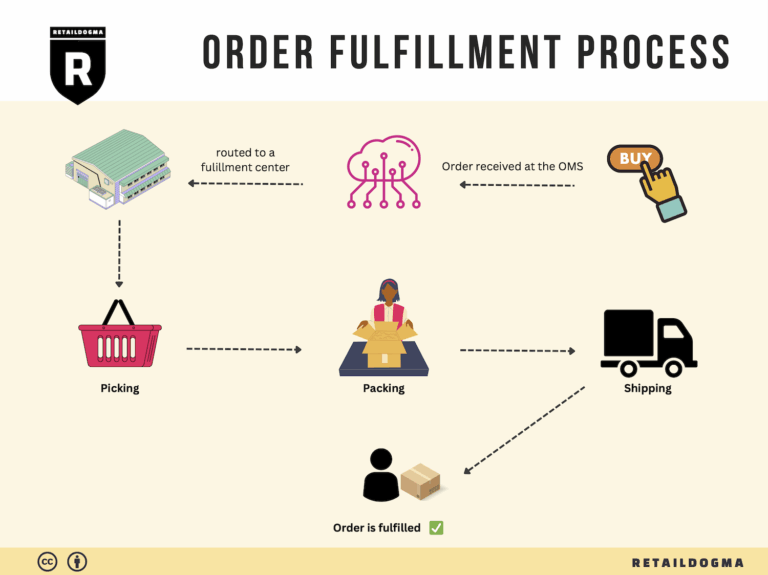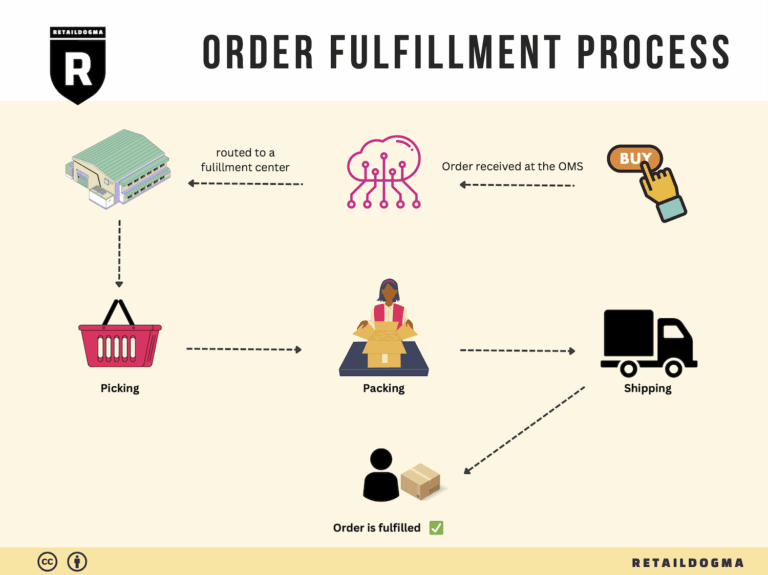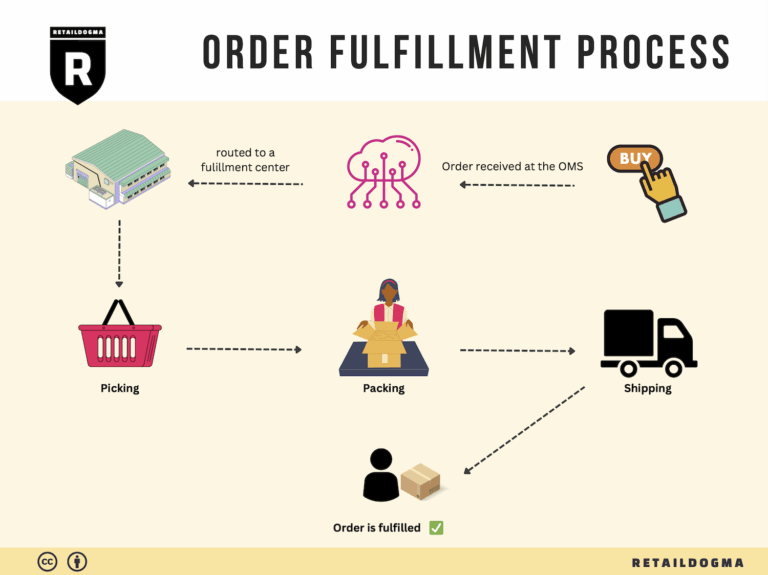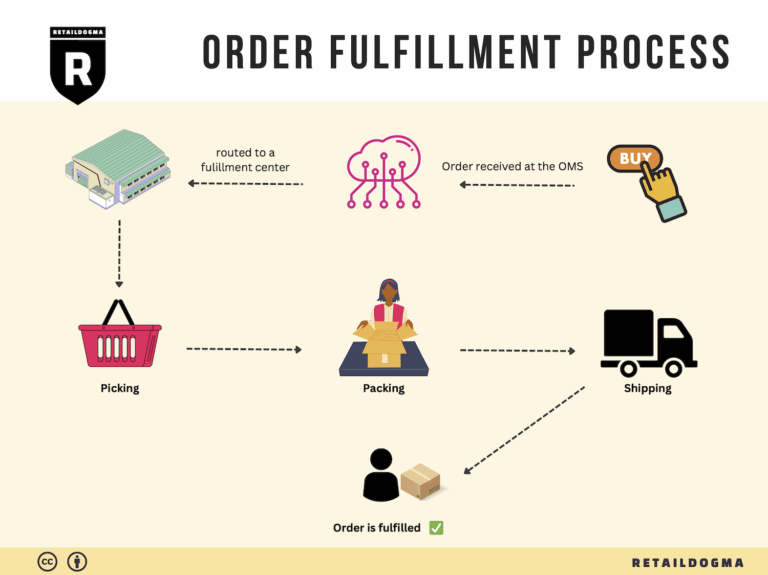Ecommerce Fulfillment Services: The Ultimate Guide (2025)
What is E-commerce Fulfillment? An Introduction for Growing Businesses
Understanding E-commerce Fulfillment
As your online business begins to grow, you might find yourself facing a common challenge: the overwhelming task of packing and shipping orders. Managing this critical aspect of your operations can feel daunting, especially when you’re juggling inventory, customer service, and marketing. Yet, fulfillment is simply defined as the process of getting a product from your warehouse to your customer’s doorstep. This process is not just about shipping; it encompasses everything from order processing and inventory management to returns handling and customer support.
In this guide, we will explore the various facets of e-commerce fulfillment that are vital for scaling your business effectively. We will discuss different fulfillment models, including Third-Party Logistics (3PL) and Fulfillment by Amazon (FBA), highlighting the advantages and disadvantages of each. Understanding these options is essential as they can significantly impact your operational efficiency and customer satisfaction.
Moreover, we will delve into the core services involved in the fulfillment process. This includes inventory management, order processing, picking and packing, shipping, and returns management. Each of these components plays a crucial role in ensuring that your customers receive their orders promptly and in excellent condition.
Selecting the right fulfillment partner can make or break your logistics strategy. We will provide practical tips on how to evaluate potential partners based on factors such as technology integration, scalability, service quality, and cost. Making an informed choice here will not only streamline your operations but also enhance your overall customer experience.
Pricing is another critical consideration when it comes to fulfillment. We will break down the typical costs associated with different fulfillment models and services, helping you understand how to budget effectively as you grow.
Ultimately, the goal of this guide is to empower you as a business owner to make smart, informed decisions about your logistics. By understanding the intricacies of e-commerce fulfillment, you can reduce overwhelm, improve efficiency, and focus on what you do best—growing your business. Whether you’re just starting out or looking to optimize your existing processes, this guide will serve as a comprehensive resource to help you navigate the complexities of order fulfillment.
What You’ll Learn In This Guide
- What is E-commerce Fulfillment? An Introduction for Growing Businesses
- The Order Fulfillment Process: From ‘Buy’ Button to Customer’s Door
- Comparing Fulfillment Models: In-House vs. 3PL vs. Dropshipping
- A Deep Dive into Amazon FBA: Pros, Cons, and Who It’s For
- Core Services Offered by Fulfillment Centers
- How to Choose a Fulfillment Partner: A 6-Point Checklist
- Understanding Fulfillment Pricing: A Breakdown of Common Fees
- Frequently Asked Questions (FAQs) about Fulfillment
- Conclusion: Is Outsourcing Fulfillment the Right Move for Your Business?
- Important Disclaimer
The Order Fulfillment Process: From ‘Buy’ Button to Customer’s Door
1. Receiving Inventory
The order fulfillment process begins with receiving inventory, which is a critical step in ensuring that your e-commerce operations run smoothly. When products arrive at your fulfillment center, they must be carefully counted, inspected for quality, and recorded in your inventory management system. This is where Stock Keeping Units (SKUs) come into play, as they help in tracking each item accurately.
Why It’s Important: Properly receiving inventory ensures that you have the right products in stock, which minimizes the risk of stockouts and overselling. An organized receiving process helps maintain accurate inventory levels, which is essential for meeting customer expectations and maintaining brand reputation.
2. Warehouse Storage
Once the inventory is received, the next step is warehouse storage. This involves categorizing and storing products in a systematic manner that facilitates efficient retrieval. Items are typically placed in designated locations based on their SKUs, size, and demand frequency. Effective warehouse management systems help in optimizing this process.
Why It’s Important: Efficient storage practices reduce the time it takes to locate and retrieve products when orders are placed. Properly organized storage not only improves the speed of order fulfillment but also minimizes the risk of errors during picking and packing. Additionally, it allows for better space utilization, which can lead to cost savings.
3. Order Picking
Order picking is the process of selecting the right products from the warehouse to fulfill customer orders. This is usually guided by a pick list, which outlines the specific items to be collected, including their SKUs, quantities, and locations within the warehouse. Businesses can utilize manual picking teams or automated systems, such as robots, to enhance efficiency.
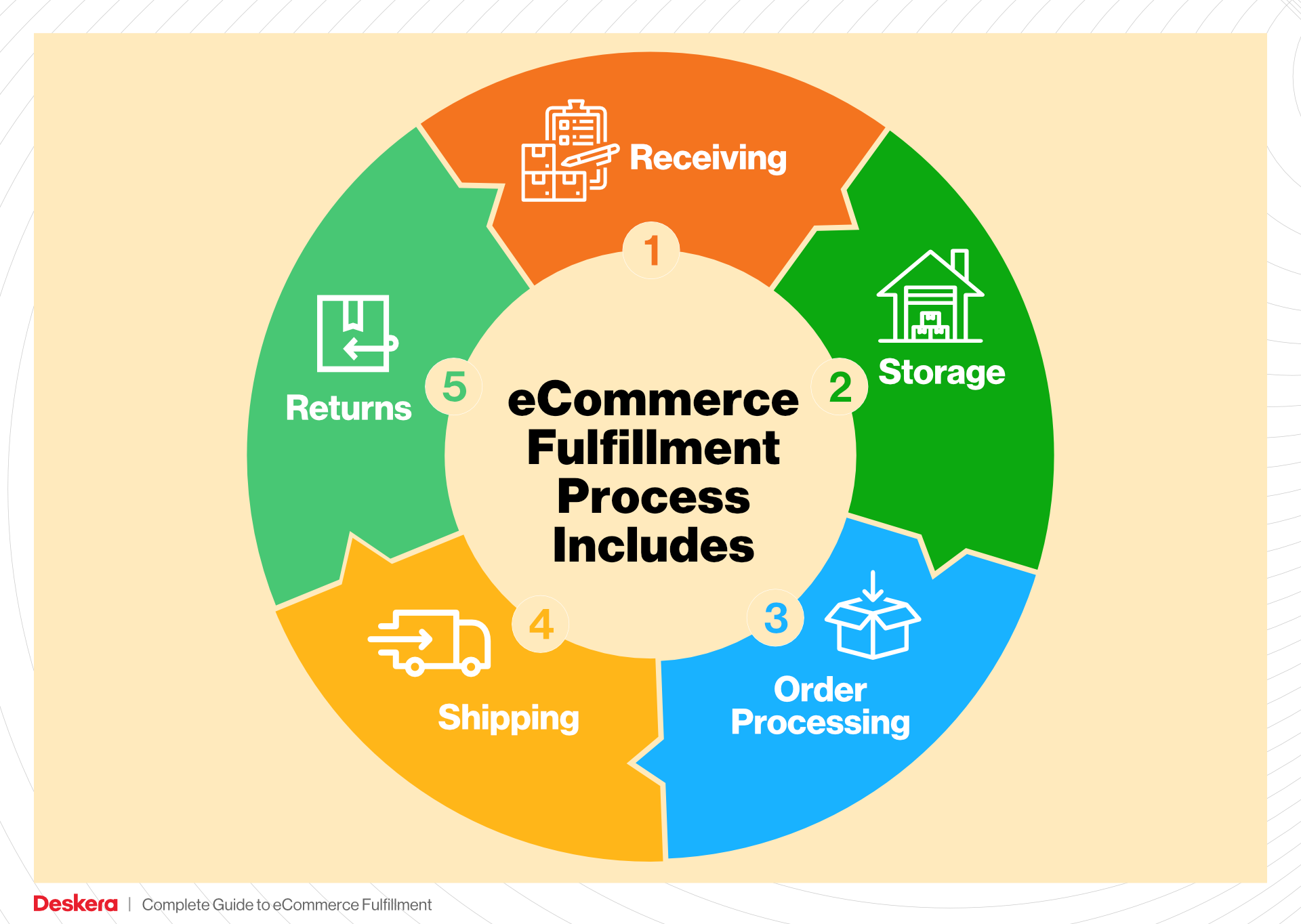
Why It’s Important: The accuracy and speed of order picking significantly impact overall fulfillment performance. Errors at this stage can lead to customer dissatisfaction due to incorrect or incomplete orders, which can ultimately harm your brand’s reputation. By optimizing the picking process, you can ensure a higher level of accuracy and efficiency, which is essential for scaling your e-commerce operations.
4. Order Packing
Once items have been picked, they move to the packing stage. Here, products are carefully packed into boxes or envelopes, using appropriate packing materials to protect them during transit. This process often involves calculating dimensional weight (DIM weight) to optimize shipping costs. Including return shipping materials and labels can also streamline the returns process.
Why It’s Important: Proper packing is crucial for ensuring that products arrive at the customer’s doorstep in good condition. Additionally, efficient packing reduces shipping costs, which can improve your profit margins. A well-executed packing process also enhances the customer experience, as it reflects your commitment to quality and care in delivering orders.
5. Shipping & Delivery
The final step in the order fulfillment process is shipping and delivery. Once orders are packed, they are handed over to carriers for transport to the customer. This may involve multiple shipping methods, especially for last-mile delivery. Businesses must choose the right carriers based on cost, reliability, and delivery speed to meet customer expectations.
Why It’s Important: The shipping and delivery stage is often the moment of truth for customer satisfaction. Timely and reliable delivery can make or break a customer’s experience with your brand. Moreover, efficient logistics planning can help you avoid delays and reduce costs, which is vital for maintaining profitability as your business scales. Ensuring clear communication with customers about tracking and delivery updates can further enhance their experience and loyalty.
In summary, each step of the order fulfillment process plays a vital role in delivering an exceptional customer experience. By focusing on these five key stages—receiving inventory, warehouse storage, order picking, order packing, and shipping & delivery—you can streamline your operations, reduce costs, and ultimately drive growth in your e-commerce business.
Comparing Fulfillment Models: In-House vs. 3PL vs. Dropshipping
Fulfillment Model Comparison
| Model | Who Handles Inventory | Best For (Business Stage) | Key Advantage | Key Disadvantage |
|---|---|---|---|---|
| In-House Fulfillment | The business itself | Startups to mid-sized companies | Full control over inventory and processes | High overhead costs and labor requirements |
| Third-Party Logistics (3PL) | Outsourced logistics provider | Growing businesses | Scalability and reduced operational burden | Less control over inventory and potential costs can rise |
| Dropshipping | Supplier or manufacturer | New and small businesses | Low upfront investment and minimal risk | Lower profit margins and reliance on suppliers |
In-House Fulfillment
In-house fulfillment involves managing the entire order fulfillment process within your own facilities. This model is often adopted by startups and mid-sized businesses that want to maintain direct oversight over their inventory, order processing, and shipping activities. By handling fulfillment in-house, businesses can ensure that they adhere to their own quality standards and can quickly adapt to changes in demand or inventory levels. However, this control comes with significant costs. Businesses must invest in warehousing, inventory management systems, staffing, and logistics, which can become burdensome as they scale. Additionally, as order volumes increase, the complexity of operations may lead to inefficiencies or errors, potentially impacting customer satisfaction. Overall, in-house fulfillment is best suited for businesses that prioritize control and quality but are prepared to handle the associated costs and complexities.
Third-Party Logistics (3PL)
Utilizing Third-Party Logistics (3PL) providers allows businesses to outsource their fulfillment needs to specialized logistics companies. This model is particularly beneficial for growing businesses that experience fluctuating order volumes or seasonal spikes. 3PL providers offer scalable solutions, enabling businesses to focus on core operations such as marketing and product development while leaving logistics management to experts. They typically handle warehousing, inventory management, order processing, and shipping, which can reduce the operational burden on the business. However, outsourcing fulfillment can lead to less control over inventory and fulfillment processes, and businesses may encounter rising costs as they scale. Moreover, reliance on a third-party provider means that any issues in their operations could directly affect your business’s reputation and customer satisfaction. Therefore, 3PL is an excellent option for businesses looking to grow quickly without the overhead of managing logistics in-house.
Dropshipping
Dropshipping is a fulfillment model where businesses sell products without holding inventory. Instead, when a customer makes a purchase, the order is fulfilled directly by a supplier or manufacturer who ships the product to the customer. This model is particularly attractive for new and small businesses due to its low upfront investment and minimal risk, as there is no need to purchase inventory before making sales. Furthermore, dropshipping eliminates the complexities of warehousing and logistics, allowing entrepreneurs to focus on marketing and customer acquisition. However, the dropshipping model comes with its own set of challenges. Businesses often face lower profit margins since they rely on suppliers for fulfillment, which can also lead to inconsistent product quality and shipping times. Additionally, businesses have limited control over inventory levels and may struggle with supplier reliability, which can impact customer satisfaction. Thus, while dropshipping offers a low-barrier entry into e-commerce, it requires careful supplier selection and management to ensure a positive customer experience.
In conclusion, choosing the right fulfillment model depends on your business stage, operational goals, and resources. Each model offers distinct advantages and disadvantages, and understanding these nuances will empower you to make informed decisions that align with your strategic objectives.
A Deep Dive into Amazon FBA: Pros, Cons, and Who It’s For
Understanding Fulfillment by Amazon (FBA)
Fulfillment by Amazon (FBA) is a service that enables e-commerce sellers to store their products in Amazon’s fulfillment centers. Amazon takes care of storage, packaging, shipping, and customer service on behalf of the sellers. By leveraging Amazon’s extensive logistics network, sellers can reach millions of customers while focusing on growing their business.
How FBA Works
-
Product Listing: Sellers create product listings on Amazon. During this process, they can opt for FBA, which allows them to utilize Amazon’s fulfillment services.
-
Inventory Shipment: Sellers send their inventory to Amazon’s fulfillment centers. This involves preparing products according to Amazon’s guidelines, which include labeling and packaging requirements.
-
Storage: Once the products arrive at the fulfillment center, they are stored until an order is placed. Amazon manages inventory levels, ensuring that items are readily available for shipment.
-
Order Processing: When a customer places an order, Amazon picks, packs, and ships the product directly to the customer. This process is streamlined through Amazon’s sophisticated logistics and warehousing systems.
-
Customer Service: Amazon handles all customer inquiries, returns, and refunds. This alleviates the burden on sellers and enhances the customer experience.
-
Performance Metrics: Sellers can monitor their sales, inventory levels, and customer feedback through the Amazon Seller Central dashboard, allowing for strategic adjustments to their operations.

Pros of FBA
1. Prime Eligibility
One of the most significant advantages of FBA is that products become eligible for Amazon Prime. This status attracts millions of Prime members who prioritize fast, free shipping. Prime eligibility can significantly enhance a seller’s visibility and sales potential.
2. Customer Trust
Products fulfilled by Amazon benefit from the company’s established reputation for reliability and quality service. Customers are more likely to purchase items fulfilled by Amazon due to the assurance of prompt delivery and hassle-free returns, which can lead to increased sales for sellers.
3. Multi-Channel Fulfillment
FBA is not limited to Amazon sales. Sellers can use FBA to fulfill orders from other sales channels, including their own websites and other e-commerce platforms. This flexibility allows businesses to streamline their logistics and provide a consistent customer experience across multiple channels.
4. Simplified Logistics
By outsourcing fulfillment to Amazon, sellers can focus on core business activities such as marketing, product development, and customer engagement. Amazon’s expertise in logistics means that sellers benefit from efficient inventory management, reduced shipping times, and lower operational complexities.
Cons of FBA
1. High Fees
While FBA provides numerous benefits, it comes with costs that can cut into profit margins. Sellers incur fees for storage, fulfillment, and other services. These fees can vary based on product size, weight, and time of year, making it essential for sellers to carefully calculate their pricing strategies to maintain profitability.
2. Strict Inventory Rules
Amazon imposes strict guidelines regarding inventory management. Sellers must adhere to policies about storage limits and inventory performance metrics. Failure to comply with these rules can lead to penalties, including increased fees or even account suspension.
3. Commingling Risks
FBA employs a commingling system where products from different sellers are stored together. While this can lead to faster shipping times, it also poses risks. If a customer returns a product, it may not be easy for Amazon to determine which seller the item belongs to, potentially leading to issues with refunds and returns.
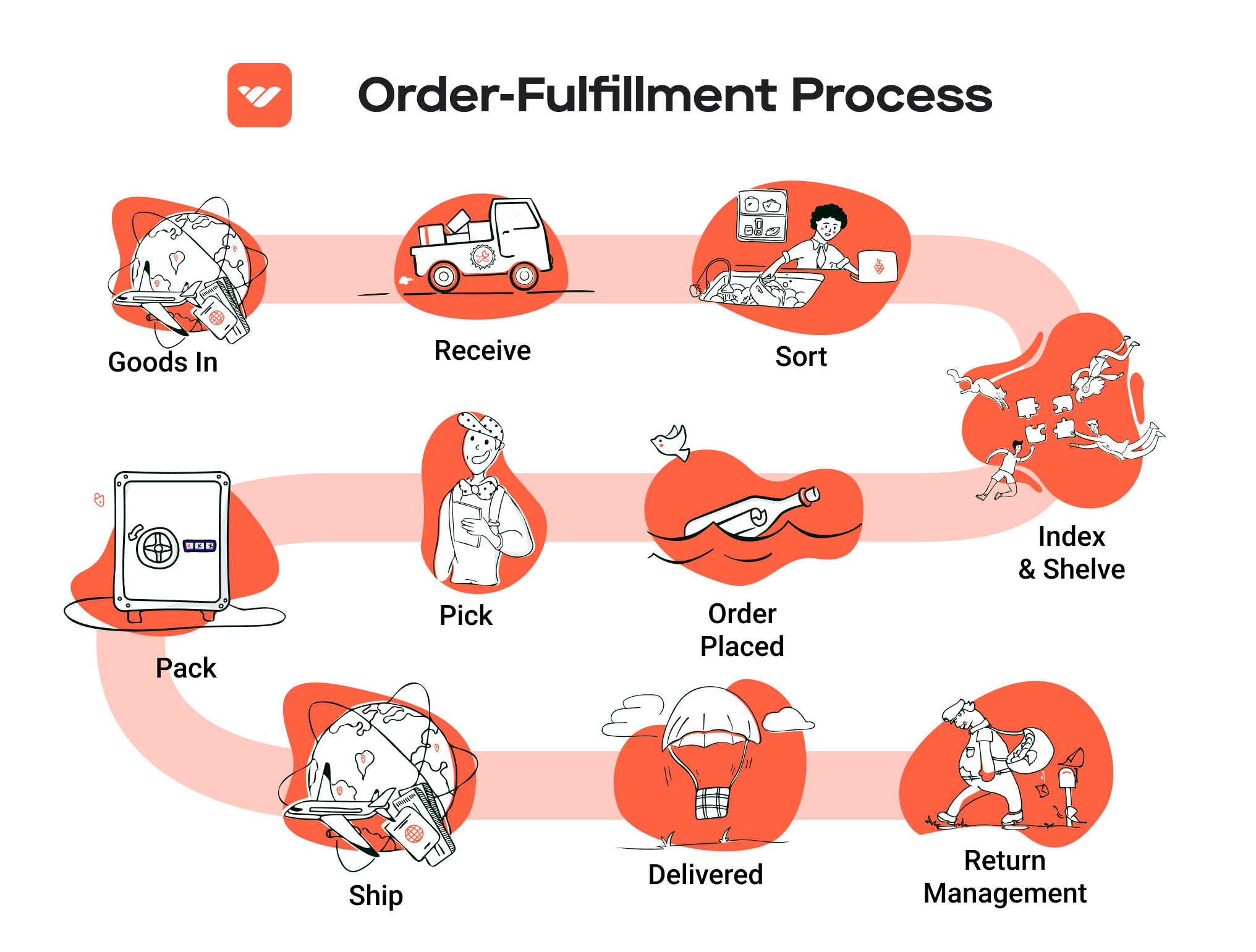
4. Limited Control Over Branding
When using FBA, sellers relinquish some control over the branding experience. Products are shipped in Amazon-branded packaging, and sellers may have limited ability to include personalized messaging or promotional materials in their shipments.
Who is FBA Best For?
FBA is particularly well-suited for small to medium-sized e-commerce businesses that want to scale quickly without the complexities of managing logistics. It benefits sellers who:
-
Sell High-Volume Products: Businesses with products that have consistent demand can leverage FBA to handle order spikes efficiently.
-
Prioritize Customer Experience: Companies that want to offer fast shipping and reliable customer service can utilize FBA’s established processes to enhance customer satisfaction.
-
Focus on Growth: Entrepreneurs looking to expand their reach and sales without getting bogged down by fulfillment logistics will find FBA a valuable asset.
-
Diverse Sales Channels: Sellers who operate across multiple platforms can benefit from FBA’s multi-channel fulfillment capabilities, allowing them to streamline their operations.
In conclusion, Fulfillment by Amazon (FBA) presents a powerful opportunity for e-commerce businesses to enhance their operational efficiency and customer service. By weighing the pros and cons and aligning them with their business goals, sellers can make informed decisions about whether FBA is the right fulfillment strategy for their growth trajectory.
Core Services Offered by Fulfillment Centers
Inventory Management & Warehousing
Inventory management and warehousing are foundational services provided by fulfillment centers. This service encompasses the systematic control of inventory levels, ensuring that products are readily available to meet customer demand while minimizing excess stock. Fulfillment centers utilize advanced inventory management software that integrates with e-commerce platforms, providing real-time visibility into stock levels, order statuses, and product locations.
Benefits to E-commerce Businesses:
-
Optimized Stock Levels: By maintaining accurate inventory counts and forecasting demand, fulfillment centers help e-commerce businesses avoid stockouts and overstock situations. This balance is crucial for maintaining customer satisfaction and reducing holding costs.
-
Efficient Space Utilization: With proper warehousing strategies, fulfillment centers maximize storage efficiency, ensuring that products are stored in a manner that allows for quick retrieval and minimal handling time. This can lead to faster order processing and shipping times.
-
Cost Savings: Centralized warehousing reduces the need for multiple storage locations, which can significantly lower overhead costs. Moreover, fulfillment centers often benefit from economies of scale, allowing them to provide lower storage fees than individual businesses could achieve independently.
Pick and Pack Services
Pick and pack services are critical components of the order fulfillment process, where items are selected from inventory (picked) and then packaged for shipment (packed). This service is often automated with advanced picking technologies or carried out by trained staff who ensure accuracy and efficiency in order preparation.
Benefits to E-commerce Businesses:
-
Accuracy and Speed: Fulfillment centers employ systematic processes to ensure that the correct items are picked and packed efficiently. This minimizes the risk of errors and returns, enhancing customer satisfaction.
-
Scalability: As e-commerce businesses grow, their order volumes can fluctuate significantly. Fulfillment centers can easily scale pick and pack operations up or down to meet changing demand without the need for businesses to hire additional staff or invest in new infrastructure.
-
Customization Options: Many fulfillment centers offer customizable packing options, including branded packaging and personalized messages. This can enhance the unboxing experience for customers, thereby strengthening brand loyalty.
Kitting and Assembly
Kitting and assembly services involve grouping multiple products into a single package or preparing items for sale as a complete set. This service is particularly beneficial for businesses that sell bundled products or need to prepare items for promotional campaigns.
Benefits to E-commerce Businesses:
-
Streamlined Operations: By outsourcing kitting and assembly, e-commerce businesses can streamline their operations and focus on core activities such as marketing and customer service. This reduces the complexity of managing multiple SKUs and the associated inventory.
-
Enhanced Customer Appeal: Bundled products often attract more customers, as they provide perceived value and convenience. Fulfillment centers can help create attractive kits that appeal to specific customer segments, driving sales and improving customer satisfaction.
-
Reduced Time to Market: With professional kitting and assembly services, businesses can quickly launch new products or promotional bundles without the logistical headaches of doing it in-house. This agility can be a significant competitive advantage in fast-paced e-commerce environments.
Returns Management (Reverse Logistics)
Returns management, or reverse logistics, is the process of handling product returns efficiently. Fulfillment centers manage the entire returns process, from receiving returned items to restocking or processing them for disposal. This service is crucial as it directly impacts customer satisfaction and retention.
Benefits to E-commerce Businesses:
-
Improved Customer Experience: A streamlined returns process enhances customer satisfaction. Fulfillment centers can provide return labels, packaging, and instructions, making it easy for customers to return unwanted products. A hassle-free return process can encourage repeat purchases.
-
Efficient Restocking: Fulfillment centers are equipped to inspect returned items and determine their resale status quickly. This efficiency reduces the time products spend out of inventory, allowing businesses to recapture lost revenue faster.
-
Data Insights: Returns management services often come with analytics and reporting features that provide valuable insights into return reasons and trends. Understanding why products are returned can help e-commerce businesses adjust their offerings, improve product quality, and refine marketing strategies.
In summary, partnering with a fulfillment center offers e-commerce businesses a suite of services that streamline operations, enhance customer experiences, and ultimately drive profitability. By leveraging these core services—inventory management and warehousing, pick and pack services, kitting and assembly, and returns management—businesses can scale effectively while maintaining high standards of service.
How to Choose a Fulfillment Partner: A 6-Point Checklist
Location & Warehouse Network
Importance:
The location of your fulfillment partner’s warehouses is crucial for minimizing shipping times and costs. A strategically located warehouse network can significantly enhance customer satisfaction by ensuring timely deliveries.
Questions to Ask:
– Where are your warehouses located, and how does that align with my primary customer base?
– What is your average shipping time to my main markets?
– Do you have warehouses in regions that can help me reach international customers if needed?
Technology & Integrations
Importance:
In today’s digital landscape, robust technology and seamless integrations with your e-commerce platform are essential for efficient order processing, inventory management, and real-time tracking. A fulfillment partner should offer a technology stack that supports automation and provides visibility into inventory levels and order status.
Questions to Ask:
– What order management system do you use, and how does it integrate with my e-commerce platform?
– Do you provide real-time inventory tracking, and how is this data shared with clients?
– What kind of reporting and analytics capabilities do you offer to help me monitor my fulfillment performance?
Specializations (e.g., Cold Storage, Oversized Items)
Importance:
If your product line includes specialized items such as perishables, hazardous materials, or oversized goods, choosing a fulfillment partner with expertise in handling these products is vital. Their ability to meet specific storage and handling requirements can prevent product spoilage or damage.
Questions to Ask:
– Do you have the necessary facilities and equipment to handle my specific product types?
– What certifications do you hold for specialized storage (e.g., food safety certifications for cold storage)?
– Can you provide examples of how you have successfully managed similar products for other clients?
Scalability & Capacity
Importance:
As your business grows, your fulfillment needs will evolve. A partner that can scale operations in line with your growth will help you avoid disruptions and maintain service quality. Understanding their capacity limits is also critical to ensure they can handle peak seasons without compromising efficiency.
Questions to Ask:
– What is your current capacity, and how quickly can you scale operations if my order volume increases?
– Have you managed spikes in demand during peak seasons? Can you share examples?
– What contingency plans do you have in place for unforeseen demand surges or supply chain disruptions?
Pricing and Contracts
Importance:
Understanding the pricing structure and contract terms is essential for budgeting and financial planning. Hidden fees can erode profit margins, so clarity on pricing is crucial. Additionally, flexible contract terms can help you adapt to changing business conditions.
Questions to Ask:
– Can you provide a detailed breakdown of your pricing structure, including any additional fees?
– Are there minimum order requirements or long-term contracts that I need to be aware of?
– What is your policy on pricing adjustments, especially during peak seasons or for long-term partnerships?
Customer Support & Reviews
Importance:
Effective customer support is vital for resolving issues quickly and maintaining a smooth operation. Additionally, reviews and testimonials from other clients provide insight into the partner’s reliability and service quality.
Questions to Ask:
– What levels of customer support do you offer, and how can I reach you if issues arise?
– Can you share client testimonials or case studies that highlight your service quality?
– How do you handle complaints or operational hiccups, and what is your typical response time?
Conclusion
Choosing the right fulfillment partner is a critical decision that can impact your e-commerce business’s success. By using this checklist, you can ensure that you evaluate potential partners thoroughly and select one that aligns with your operational needs, customer expectations, and long-term growth strategies. Taking the time to ask the right questions will lead to a more informed decision and a partnership that supports your business’s ambitions.
Understanding Fulfillment Pricing: A Breakdown of Common Fees
Initial Setup Fees
When partnering with a fulfillment service provider, businesses often encounter initial setup fees. These charges cover the costs associated with onboarding your products into their system. This may include inventory setup, software integration, and the initial configuration of your account.
Typically, setup fees can range from a few hundred to several thousand dollars, depending on the complexity of your inventory and the level of service required. For instance, if you have a large number of SKUs or require custom software integrations, expect higher fees. It’s essential to ask for a detailed breakdown of what these fees cover to avoid unexpected costs later.
Receiving Fees
Receiving fees are charged when your inventory arrives at the fulfillment center. These fees are based on the amount of inventory being processed, including counting, inspecting, and entering the items into the warehouse management system (WMS).
Receiving fees are generally calculated per unit or per hour of labor required to handle the incoming stock. For example, a fulfillment center may charge $0.25 per item received or $50 per hour for labor. Understanding the specifics of these fees will help you budget effectively, especially during peak seasons when you may have larger shipments.
Storage Fees (per pallet/bin)
Storage fees are incurred for the physical space your inventory occupies in the fulfillment center. These fees can vary significantly based on the size and type of storage utilized, typically charged on a per-pallet or per-bin basis.
For instance, a common pricing model might be $15 to $30 per pallet per month, while bin storage might be charged at $5 to $10 per bin per month. It’s crucial to consider your product turnover rate; slow-moving items may lead to higher storage costs over time. Regularly reviewing your inventory and optimizing your storage strategy can help minimize these fees.
Pick & Pack Fees (per item/order)
Pick and pack fees are charged for the labor involved in retrieving items from storage and preparing them for shipment. This fee usually encompasses the picking of items, packing them into boxes, and labeling for shipment.
Fulfillment centers may charge a flat fee per order or a variable fee per item. For example, you might see a charge of $1.50 per item picked and packed, or a flat fee of $5 per order regardless of the number of items. If your business has a wide variety of products with different picking complexities, ensure you discuss how these fees will be calculated to avoid surprises.
Shipping Fees
Shipping fees can be one of the most significant costs associated with order fulfillment. These fees are determined by multiple factors, including the size and weight of the package, the shipping method chosen, and the destination.
Most fulfillment providers offer discounted shipping rates through partnerships with major carriers, such as FedEx, UPS, or USPS. These shipping fees can be based on actual weight or dimensional weight, whichever is greater. For example, a package weighing 5 lbs and measuring 20” x 15” x 10” will incur charges based on its dimensional weight if that is higher than its actual weight. To gain a clear understanding of shipping costs, review the provider’s shipping policies and ask for a breakdown of rates based on different shipping scenarios.
Tips for Getting an Accurate Quote
-
Be Transparent: Provide detailed information about your product sizes, weights, and inventory turnover rates. The more accurate your data, the more precise the quote will be.
-
Ask for Itemized Quotes: Request a breakdown of all potential fees, including setup, receiving, storage, pick and pack, and shipping. This will help you understand where costs may arise.
-
Consider Seasonal Fluctuations: If your business has peak seasons, ask how fees might change during those times. Some fulfillment centers may offer seasonal pricing.
-
Negotiate Terms: Many fulfillment providers are open to negotiation, especially if you anticipate high volumes. Don’t hesitate to discuss your needs and seek favorable terms.
-
Evaluate Scalability: As your business grows, ensure that the fulfillment center can scale with you without imposing excessive fees that could impact your margins.
By understanding these common fulfillment pricing models and following these tips, you can make informed decisions that align with your business goals and budget.
Frequently Asked Questions (FAQs) about Fulfillment
1. What is the order fulfillment process?
The order fulfillment process encompasses all steps involved in receiving, processing, and delivering a customer’s order. This includes inventory management, order processing, picking, packing, shipping, and handling returns. Efficient fulfillment is essential for customer satisfaction and retention.
2. How does order fulfillment impact customer satisfaction?
Order fulfillment directly affects customer satisfaction by determining how quickly and accurately a customer’s order is delivered. Timely delivery, accurate order picking, and quality packaging enhance the customer experience, while delays or errors can lead to dissatisfaction and lost business.
3. What’s the difference between a warehouse and a fulfillment center?
A warehouse is primarily used for storage, while a fulfillment center focuses on processing and shipping customer orders. Fulfillment centers are equipped with systems and processes for order picking, packing, and shipping, often providing additional services like returns processing, which is not typically a function of a standard warehouse.
4. What is a 3PL (Third-Party Logistics)?
A 3PL is a service provider that manages logistics and supply chain functions for businesses. This can include warehousing, transportation, and order fulfillment. Partnering with a 3PL allows e-commerce businesses to leverage specialized expertise and technology, helping them scale operations without investing in infrastructure.
5. How much do fulfillment services cost?
Fulfillment service costs vary based on factors such as order volume, storage space, shipping methods, and additional services provided (like returns processing or custom packaging). Typically, costs can include storage fees, picking and packing fees, and shipping fees, which can range from a few cents to several dollars per order.
6. What are the main challenges in order fulfillment?
Common challenges include inventory management issues (such as stockouts or overstock), logistics planning failures (leading to delayed or damaged shipments), and demand forecasting inaccuracies. Addressing these challenges requires robust systems and processes to ensure smooth operations.
7. How can I improve my order fulfillment efficiency?
To enhance fulfillment efficiency, consider implementing an integrated order management system, optimizing warehouse layout for faster picking, and utilizing data analytics for better demand forecasting. Regular training for staff and establishing clear protocols can also streamline operations.
8. What role does technology play in order fulfillment?
Technology is crucial in order fulfillment, as it enables automation of processes, real-time inventory tracking, and improved communication across supply chain partners. Systems like Warehouse Management Systems (WMS) and Enterprise Resource Planning (ERP) can significantly enhance efficiency and accuracy.
9. How can I handle returns effectively?
To manage returns effectively, include return labels and packaging in shipments, clearly communicate return policies to customers, and establish a streamlined process for inspecting and restocking returned items. Implementing a dedicated returns management system can further enhance efficiency.
10. What are best practices for inventory management in fulfillment?
Best practices include maintaining accurate inventory records, using just-in-time inventory strategies to minimize storage costs, regularly reviewing stock levels, and utilizing inventory management software. Implementing a first-in-first-out (FIFO) approach can also help reduce obsolescence and ensure product freshness.
Conclusion: Is Outsourcing Fulfillment the Right Move for Your Business?
Evaluating the Benefits of Outsourcing Fulfillment
Outsourcing fulfillment can be a transformative decision for e-commerce businesses aiming to scale efficiently. By leveraging a fulfillment service, businesses can save significant time and resources. Instead of managing the complexities of warehousing, inventory management, and shipping logistics, entrepreneurs can focus on strategic initiatives such as marketing, product development, and customer engagement. This shift not only enhances productivity but also allows for a more agile response to market demands.
Scalability is another key advantage of partnering with a fulfillment provider. As your sales grow, so too do the operational challenges. A fulfillment partner can accommodate fluctuations in order volume, seasonal spikes, and even new product launches without the need for substantial investments in infrastructure or staff. This flexibility enables businesses to scale operations smoothly while minimizing the risks associated with overextending resources.
Moreover, fulfillment services often come equipped with specialized expertise and technology that many small to mid-sized businesses may lack. From advanced inventory management systems to logistics optimization strategies, these partners can enhance order accuracy and speed, thereby improving customer satisfaction and retention.
However, the success of outsourcing fulfillment hinges on selecting the right partner. It is crucial to evaluate potential providers based on their experience, technology capabilities, and alignment with your business goals. A well-chosen partner can help propel your growth, while a poor fit could lead to disruptions and customer dissatisfaction.
Take Action
To determine if outsourcing fulfillment is the right step for your business, start by auditing your current shipping process. Analyze your operational bottlenecks, costs, and customer feedback. This assessment will provide clarity on whether a fulfillment partner could streamline your operations and support your growth objectives. Taking this proactive step can lead to more informed decisions and ultimately, greater success in your e-commerce journey.
Important Disclaimer
⚠️ Important Disclaimer
The information in this guide is for educational purposes. Fulfillment services, pricing, and platform features change frequently. Always conduct your own due diligence and consult with providers directly before making business decisions.

